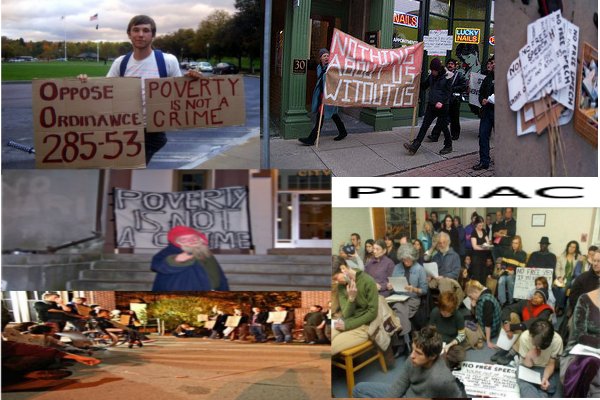http://media.www.smithsophian.com/media/storage/paper587/news/2009/02/19/News/Students.Oppose.Downtown.Business.Development.Proposal-3636457.shtmlStudents oppose downtown business development proposal
Christina NyquistIssue date: 2/19/09 Section:
NewsToday, Smith students will team up with locals to protest Smith College President Carol Christ's signing of the Northampton's Business Improvement District (BID) Plan. The protestors plan to gather at City Hall at 4:30 p.m., march along Main Street to College Hall on Smith's campus, and then march back downtown.
Local entrepreneurs launched their campaign to establish a Northampton BID on Oct. 7. The Northampton Downtown Web site defines a BID as a "contiguous geographic area in which property owners vote to initiate, manage, and finance supplemental services above and beyond the City's services in their district." The site states that supporters view the BID as "a powerful tool to enhance downtown and increase the likelihood of its long-term success and vitality." It also claims that, "for Northampton, the purpose of the BID is to return Downtown Northampton to a vital visitor destination that successfully competes as an entertainment, restaurant and shopping district." The BID calls on the City of Northampton to fund the plan at $35,000 [actually, $85,000] annually, to finance equipment and maintenance, provide police patrol and "enhanced snow removal policies" within the district, fund a capital program for street, sidewalk and park improvements, support the Academy of Music, provide funding for trash removal, implement bike paths within the district and continue its ownership and funding of decorative light poles was well as major maintenance and repair.
The plan's other program areas include maintenance and landscaping, featuring a CLEAN TEAM to sweep sidewalks, landscape and remove graffiti; parking and transportation; and Public Safety to "increase the sense of safety and security, [and] reduce crime, homelessness and aggressive panhandling in downtown Northampton." According to protest organizer Anne Watanabe '12, Smith's position on the matter is crucial to the plan's success, as Smith property constitutes 40 percent of Northampton's business district property and only 60 percent of property owners must sign before City Council can make its final decision.
When asked about her stance on the BID, President Christ said, "A vibrant and appealing downtown, with thriving retail, dining and cultural options, is important to keeping Northampton successful and economically viable. Moreover, it is an important asset in recruiting students, faculty and staff to Smith.""
Creating a BID is a proven way of regularizing the funding and initiatives needed to maintain and improve that asset. Students and their families appreciate the fact that, in Northampton, they can experience entertainment, shopping and restaurants in the context of a downtown that is walkable, lively at all times of day and night and only steps from their front door," she continued.
President Christ stated that a portion of what the BID will pay for are things "to which Smith already contributes on an ad hoc or year-to-year basis." She cited the holiday lights as one example.
"Downtown is a centerpiece of what makes Northampton an attractive and special place for faculty and staff to live - and it can be even better if it's cleaned and maintained in a more regular fashion," Christ continued. "We want to do our part to make sure Northampton continues to thrive and to be a welcoming and culturally diverse place."
Those who oppose the BID fear that because a private board of directors would govern the plan, it will not be accountable to the public and community needs. Furthermore, opponents claim the BID would raise taxes and rent for downtown residents within the district, thereby making that area unaffordable for many who currently live there, including Five College students.
However, according to President Christ, the BID plans were not made in a vaccume; the BID organizers held a focus group last year with Smith students to find out what they liked and disliked about Northampton. "Relatively few [students] showed up despite many and repeated invitations and confirmed RSVPs," she said.According to Christ, the focus group found that Smith students are interested in forming traditions between the college and town, such as Bag Days for students, student discounts, senior pub crawls and first-year nights at Herrell's. The group also found that students are concerned about the homeless population and need for shelters downtown, over-priced shops and the lack of crosswalk visibility. President Christ stated that many of these concerns would be addressed by the BID either directly or indirectly.
Nonetheless, many Smith students, as well as social justice groups, find fault with the BID. They are especially concerned with the BID's commitment to increasing panhandling intervention and regulation. "Smith already has something of a reputation of being an 'ivory tower on the hill,' and I would hate to see us be a part of a process to gentrify Northampton," said Watanabe, who credits her experiences in the Smith classroom with giving her a more critical outlook on social dynamics and social inequality.
At the City Council Meeting on Thursday, Feb. 5, Northampton Mayor Clare Higgins formally withdrew and indefinitely tabled the controversial Panhandling Ordinance, which seeks to restrict panhandling downtown and provide civil means such as fines to punish violators. This withdrawal occurred just before a public hearing on the BID, which included the ordinance in its plan.
In addition to the protest, the Smith opposition group held a "teach-in" at the Campus Center on Feb. 16 and 18, with representatives from social justice groups Poverty is Not a Crime and Arise for Social Justice, as well as a call-in to President Christ and City Councilor Paul Spector, who serves as a member of the Smith College Community Advisory Board."I just hope that Carol Christ will look out her window on Thursday to see a lot [of] Smith students demanding Smith's withdrawal of its signature from the BID," said Watanabe.

